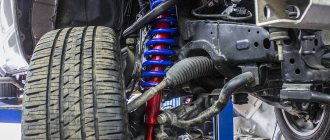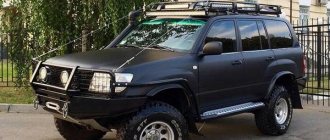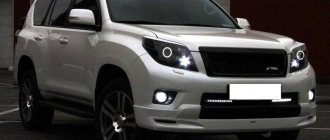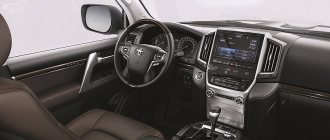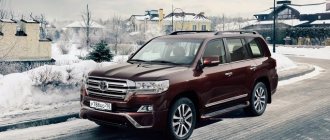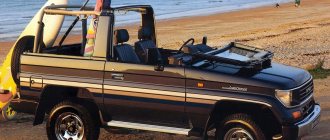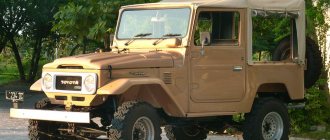The Land Cruiser 100 SUV was in serial production from 1998 to 2008. It was assigned the internal classification of Station Wagon immediately after its release at the initiative of the manufacturer. The first acquaintance with the consumer took place at the beginning of 1997 at the international Tokyo Motor Show. A successful presentation made it possible to immediately put the car into production, and already in 1998 the first sales started.
This is a classic representative of frame SUVs. It is distinguished by the traditional placement of units, as well as an independent torsion bar suspension installed in the front. The only difference was the Land Cruiser 105 modification, which had the GX package. Here, in the front part, the dependent suspension, equipped with a bridge with springs, has been preserved.
Model history
At one time, the Land Cruiser 100 version became the embodiment of the accumulated experience that Toyota had been collecting for several decades. The new car was presented to the American public in early 1998, at the famous automobile show held in Chicago. European consumers got acquainted with the model the same year at the Geneva Auto Show.
Compared to its predecessor, the Toyota Land Cruiser J100 has noticeably increased in size. Its length has increased by 9 cm, the car has also become wider by 15 cm and has increased in track. These parameters made it possible to increase the interior space, adding comfort to it. The increase in size entailed the need to strengthen the structure, the strength of which increased to 50%.
Indicators of longitudinal, transverse, and diagonal stiffness have been increased thanks to the use of new materials. Steel sheets were used in the design of the variable profile and some other reinforcing segments of the Toyota Land Cruiser J100. To protect parts of the lower part of the body from corrosion, manufacturers used shields made of a special resistant alloy.
With the entry of the Toyota concern into the overseas market, the need arose to create a full-size SUV, which became the reason for the appearance of the V8 engine. American consumers were presented with a “luxury” modification of the Land Cruiser 100 called Lexus LX470. As an alternative, Toyota Sequoia, equipped with Cruiser units, was proposed.
The year 2001 for the Toyota concern was marked by the celebration of the 50th anniversary of the release of the Land Cruiser. During this time, according to company specialists, they managed to sell about 4 million cars of this brand.
In honor of this significant date, the production of an anniversary series of the legendary brand, called the 50th Anniversary, was launched. This model is particularly luxurious, both in the exterior and interior finishes. However, the anniversary series was released in a fairly modest edition. Today there are no more than 400 copies in the Russian Federation.
Body and interior
The external design of the 100th model met all the requirements of the executive class, which could be noted for various reasons:
- massive hood;
- volumetric headlights, the optical elements of which were equipped with two-stage multi-reflectors;
- a solid bumper that goes around the sides;
- powerful wheel arches that protruded noticeably outward;
- increasing the glazing area;
- large door widths.
It was decided to cover the roof using non-woven materials. Various modifications have acquired an electrically controlled hatch. The device was available in two versions: in the first case, a folding hatch design was installed, in the second, a sliding hatch was installed.
Much attention was paid by the manufacturers to the security system, which included the following range of devices and devices:
- power steering;
- ABS;
- hydraulic booster for the brake system;
- front seat airbags;
- seat belt retensioners.
Amenities and disadvantages inside
Interior comfort, although inferior to products from famous German brands, remains at a decent level. Manufacturer's defects:
- Inconvenient placement of buttons that control the headlight washers, heated seats and steering wheel. To enable one of these options, the driver is forced to distract himself from the controls, leaning towards the required button.
- The “electric suction” is not visible, and there is no backup indicator.
- The USB port blocks access to the cigarette lighter socket when the device is turned on. This drawback is especially relevant due to the large number of devices connected to the USB connector - radios, water heaters, mobile phone chargers, etc.
But some shortcomings do not spoil the impressions of the salon, thanks to:
- A convenient graphical dashboard, a colorful multimedia screen, wide push-button functionality for controlling the microclimate in the cabin and external elements (rotating mirrors, etc.).
- Standard car radio in CD format and acoustics with spacious, clear and powerful sound.
- Reliable insulation from external noise.
- Universal adjustment of the front seats, depending on the height of the driver and passenger. The possibility of precise adjustment is provided, taking into account the characteristics of a person’s build.
- Comfortable and spacious interior - if you remove the rear row of seats, the remaining space allows you to place a full-fledged sleeping place. In addition to accommodating five adult passengers, there is room inside the car for additional luggage.
- The presence of an automatically controlled top hatch.
- Availability of personal lighting for passenger seats and driver's seat.
The interior design raises some complaints.
Engines Toyota Land Cruiser J100
For the then new Land Cruiser 100 model, manufacturers provided several powertrain options. This decision was dictated by the need to attract the maximum number of consumers, which subsequently more than paid off. Thus, the hundredth Cruiser could boast a number of different engines.
- The V8 petrol unit of the 2UZ-FE series received an engine capacity of 4.7 liters with a power of 205 horsepower.
- The 1HD-FTE diesel unit, which had an in-line six design, had a volume of 4.2 liters and a power of 205 horsepower.
- The 1FZ series diesel engine (also in-line six) with a volume of 4.5 liters, which gained popularity in the previous version of the car, has been preserved.
Interesting fact. A significant part of the 1HD-FTE engines received a bonus in the form of twin-turbocharging, which increased power to 250 horsepower. At the same time, the naturally aspirated modification of this unit, labeled 1HZ, had a power of 135 horsepower.
The greatest danger to a 1HD turbodiesel is the carbon deposits that form in the cylinder head. The consequence is coking of the EGR intake valve after 300,000 km.
If a strange ringing or suspicious knocking noise appears, you must take immediate action. Plus, a 4.2 liter turbodiesel requires systematic valve adjustment. It is recommended to make the next adjustment after every 50,000 mileage.
It is important to know. The estimated cost of fuel injectors is about 15,000 rubles, the cost of a turbine is at least 46,000 rubles. The service life of both devices does not exceed 500,000 km.
The injection pump is even less reliable; it must be serviced after 200,000 km. At the same time, the cost of the new unit will be about 42,000 rubles. If the situation is not going well, they may offer to use a repair kit at a price of 5,000 rubles.
Periodic malfunctions in the operation of the control solenoid (abbreviated as SPV), the cost of which is at least 22,000 rubles, were also noted. The advance valve, which costs from 10,000 rubles, is also not reliable.
Dimensions of Land Cruiser 100
If we talk about such an indicator as the dimensions of the Land Cruiser 100, then in the most popular modification they look like this:
- length – 489 cm;
- width – 194 cm;
- height – 188 cm;
- ground clearance size - 22 cm.
The dimensions of the Toyota Land Cruiser 100 are quite impressive, and the car can easily overcome any road obstacle.
Transmission
The Toyota Land Cruiser J100 was originally equipped with two transmission options: firstly, the MKP-5, and secondly, the AKP-4. Later, the automatic transmission was also produced in a five-speed version. The 100th Cruiser also received a stationary all-wheel drive, equipped with a low gear.
It is worth noting. A five-speed manual transmission was included exclusively with diesel units. It has impeccable performance characteristics, for which it received the nickname “eternal”.
Automatic transmissions in a four-speed version were produced until 2003, they were marked _ A340F. The design of this box turned out to be very successful. The owners highly appreciated the high reliability and low maintenance of the device, which did not require repairs up to 400,000 km.
Still, the weak link of this design is the torque converter, which, as a rule, is the first to fail. The result is unwanted vibrations, and then beatings, leading to breakdowns of other gearbox components.
Transmission
The choice of gearbox is available only to those who purchased a VX with a turbodiesel. Here the manufacturer provides both automatic and manual. Only the automatic transmission works with the VX petrol unit. The standard and GX versions are mechanically friendly. Car owners claim that both automatic and manual are equally reliable.
All modifications and versions have all-wheel drive, as well as forced differential locking.
Transmission Toyota Land Cruiser J100
After 300,000 km, the first signs of transmission wear appear. With each transition to the next driving mode, characteristic shocks or even impacts begin to be felt.
Problems arise as a result of displacements caused by the total play. This misfortune is formed taking into account the personal development of individual components. In this case, transmission repairs can cost up to 200,000 rubles. Still, it’s worth starting the inspection with the drives and then with the splined joints connecting the front axle.
After a certain time, you may encounter the problem of lock failure. Here you need to look for the cause in the servos or wiring. These elements fail upon contact with water.
The front gearbox is the next to fail due to the wear of the satellites, while the rear gearbox has a longer service life. The cost of such repairs will cost about 20,000 rubles. Leaking axle shaft seals are considered a chronic disease of long-term vehicles.
checkpoint
The four-speed automatic AW30-41LE was installed until 2002 only on top trim levels, as well as on versions from China and the Emirates. The rest of the options came with mechanics. The first turbodiesel "hundreds" after restyling in 2002–2003, for the European and Russian markets, were still with a 4-speed automatic transmission. Later, this automatic transmission was replaced with a five-speed A750F. The petrol version, after restyling, immediately came complete with a 5-speed automatic transmission.
After restyling in 2005, the Land Cruiser's automatic transmission became maintenance-free. This limited its service life to 250,000 km. If you ignore the instructions and change the oil every 60,000 km, you can extend the service life without repairs by 100-150 thousand km. A four-speed automatic was installed on Arabic and Chinese versions until 2006, but only in conjunction with a 4.5-liter inline six petrol engine.
Mechanical gearboxes are excellent in terms of reliability. They run for 350-400 thousand kilometers. The clutch also does not fail - 200,000 is its quite normal resource. The five-speed automatic had a problem for some time: slippage occurred between fourth and fifth gear. When connecting diagnostic equipment to the box, an error was generated for the throttle position sensor. But on most cars these problems have already been fixed.
Chassis
The main distinguishing feature of the Cruiser J100 from the previous version of the J80 is the presence of an independent 2-link torsion bar suspension of the front wheels, which replaced the rigid axle. The measure taken definitely improved the parameters of driving comfort, although it was criticized by off-road enthusiasts.
The main reason for dissatisfaction was the decrease in the reliability of the structure, the service life of which was noticeably reduced. At the same time, silent blocks, like ball joints or shock absorbers, are capable of traveling up to 100,000 km, despite the harsh conditions of use.
The next reason for frustration is the sophisticated hydraulic suspension system (abbreviated as ANS), as well as the capricious active height adjustment system. When used off-road, the rear part tends to settle. It happens that the cause is a sensor that controls the level-position of the body, but in most cases the problems are not limited to this.
After 200,000 km, you should more often pay attention to shock absorbers, which can leak at any time. The estimated cost of one such unit is approximately 20,000 rubles. Leaks in shock absorbers increase the operating time of the “motor”, which quickly wears out. The next in line in terms of wear resistance are the membranes on hydraulic accumulators, on which ruptures form due to exhaustion.
Proven solution . To avoid multiple problems with torsion bar suspension, many car enthusiasts use the practice of replacing it with the spring suspension of the previous model. According to experts, the loss of movement comfort is felt insignificantly.
The next problem may be the steering rack, which can leak or start knocking after 200,000 km. After 300,000 km, the weak link will be the power steering pump. The cost of an original replacement can cost about 31,000 rubles, while the cost of an analogue one is 14,000 rubles.
There is also a repair kit priced at RUB 1,000. for a unit. However, this is more of an emergency measure than a solution to the problem. In addition, sometimes you have to deal with the problem of play on the shaft from the steering.
Not for the city
The reduced efficiency of the braking system of the Cruiser Sotka is not a consequence of its malfunction; it is rather one of the features of this model. This inconvenience cannot affect traffic safety in highway or off-road conditions. Still, in urban conditions, such stretches can make you nervous.
The bulk of consumers unanimously agreed with the need to install 4-piston calipers in the front wheel brakes. This option does not differ in durability, but does not differ in costly repairs. As a result, the Toyota Land Cruiser J100, after 2004, received disc brakes on the rear axle.
Another malfunction of the brake system is associated with malfunctions of the main brake cylinder, as a rule, this occurs after a long mileage of the car. The result is characteristic failure of the brake pedal.
The price for a new GTZ unit is about 100,000 rubles, while a used one can be purchased for an amount from 20 to 70 thousand rubles. Experienced owners agree that repairing this unit is a hopeless task.
Table of average fuel costs for KamAZ of various modifications
Different types of trucks differ in operating conditions and characteristics. This circumstance affects such an important point as fuel consumption of KamAZ per 100 km. Given the diversity of the model range, the indicator changes significantly. On average, consumption varies from 25 to 30 l/100 km, but large road trains can consume over 40 l.
For popular KamAZ brands, fuel consumption according to the manufacturer’s statements is given in the table.
| Car brands | Summer norm l/100km | Winter norm l/100km |
| 65116 (tractor tractor) | 24 | 26 |
| 6460 (tractor tractor) | 25 | 28 |
| 45143 (dump truck) | 26 | 29 |
| 65115 (dump truck) | 27 | 30 |
| 65111 (tractor) | 29,8 | 30,1 |
| 53228 (onboard) | 28 | 31 |
| 6520 (tractor) | 29,2 | 32,1 |
| 44108 (tractor) | 30 | 34 |
| 45141A (tractor) | 33,5 | 36,9 |
| 43114 (onboard type) | 31 | 34 |
| 43118 (onboard) | 33 | 36 |
| 65201 (tractor) | 37,1 | 40,8 |
| 6450 (tractor tractor) | 40 | 44 |
Consumption figures are taken based on reference calculations. Information is provided by the manufacturer. However, drivers in practice may differ significantly, most often to a greater extent. This indicator is influenced by many factors, including the overall condition of the truck - engine, chassis, fuel system. It is advisable to regularly carry out technical inspections and take measurements in various situations - in summer and winter, with and without a load, on the highway and in the city.
What is acceptable fuel consumption on KamAZ?
In the field of cargo transportation, the 5320 brand tractor, equipped with a powerful engine, is popular. Fuel consumption per 100 km for such a KamAZ is about 34 liters. These are average figures, because the urban cycle for a diesel engine is always more expensive.
Lightweight versions of KamAZ with chassis 4308 use no more than 20 l/100 km. With small dimensions, the machine turns out to be more economical, but the range of tasks performed will be different. In the combined cycle, the consumption rate for such a car is 21-22 l/100 km.
The indicator is influenced by the following factors:
- Truck modification, make and type.
- Installed engine.
- Mileage and general condition.
- Time of year and operating conditions.
Winter fuel consumption rates are usually 2-4 liters higher. When making calculations, the condition of the machine should be taken into account. Brands 5490 are equipped with 800 liter tanks and under ideal conditions you can drive over 1000 km. However, for every hundred kilometers with a load of 3-4 tons, consumption will be greater.
KamAZ brand 65115 is a dump truck for various tasks. A modern modification of the chassis and engine shows an average fuel consumption of 30 liters per 100 km when driving on the highway at a speed of about 80 km/h. The base model only includes a tipper body, but trailers are also available. Based on the 65115 model, road trains are created that are used for transporting construction materials or agricultural products. Depending on what additional load is attached, consumption increases by 2-3 liters.
The 740-51-320 diesel engine is the most powerful and efficient. Its performance is 30-40 liters per 100 km, depending on the load and when driving at speeds up to 90 km/h. Engines of the Cummins series, which comply with Euro-4 standards, under ideal conditions consume up to 24 liters, but at maximum load the consumption is 37-40 l/100 km.
Reliability of Toyota Land Cruiser J100
The main indicator of the reliability of any car is its condition after a long run. Among the Land Cruiser100 models, you can find quite a few examples whose mileage has exceeded the half-million mark. As a result, they look pretty good, although certain problems still arise.
The most problematic components of this model can undoubtedly be considered the transmission, as well as the suspension. It should be borne in mind that repairing these systems is very expensive. For this reason, experts advise not to rush to enjoy the low cost of a USED car.
The body of the Cruiser suffers more than others from time to time; metal parts are subject to active corrosion attacks. Therefore, in order to preserve the presentation of your car longer, it is recommended to systematically update the anti-corrosion coating.
You should also keep an eye on the cold circuit of the air conditioner, which is also actively attacked by corrosion. After 300,000 km, problems may arise with power windows or lock drives. Nevertheless, system failures in the electrical part of the “hundredth” Cruiser are not observed.
Land Cruiser 105
The modification of the Cruiser with the number 105 at first glance has practically no differences from the usual 100. However, the model has a number of fundamental differences, because it was created on the basis of the Previous modification of the Land Cruiser 80.
As a result, the “one hundred and fifth” was equipped with a dependent suspension (in the front part), as well as a continuous axle mounted on springs. In addition, the function of the steering rack, in this modification, is performed by the gearbox.
The configuration includes only two engines: a naturally-aspirated diesel engine marked (1HZ), with an engine capacity of 4.2 liters, and a carburetor engine marked (1FZ-FE), with an engine capacity of 4.5 liters. This model was aimed at the markets of Africa and South America, as well as Australia and Russia.
Conclusion
The main caution for those wishing to purchase a Toyota Land Cruiser J100 is the high probability that the cost of repairing or replacing any component will certainly be high. Nevertheless, this model has many undeniable advantages. First of all, it is high reliability and the ability to run long distances without repairs. And excellent driving characteristics, allowing the vehicle to be used in the most difficult conditions.
Specifications
The curb weight of the car is 2650 kg, and the total weight is 3260 kg. The maximum speed is 175 km/h. Fuel tank volume – 96 l. The length of the Cruiser is 4890 mm, width is 1940 mm, and height is 1880 mm. Wheelbase – 2850 mm. The transmission is presented in the form of all-wheel drive with a locked differential. Transmission – 5-speed manual or 4-speed automatic. The brakes are equipped with a vacuum booster. The steering system is made on the basis of a steering rack. Ground clearance is 220 mm.
Such basic technical characteristics and relatively low fuel consumption allowed the Cruiser to truly be the best in its class. The unique suspension allows you to drive almost anywhere under any conditions.
